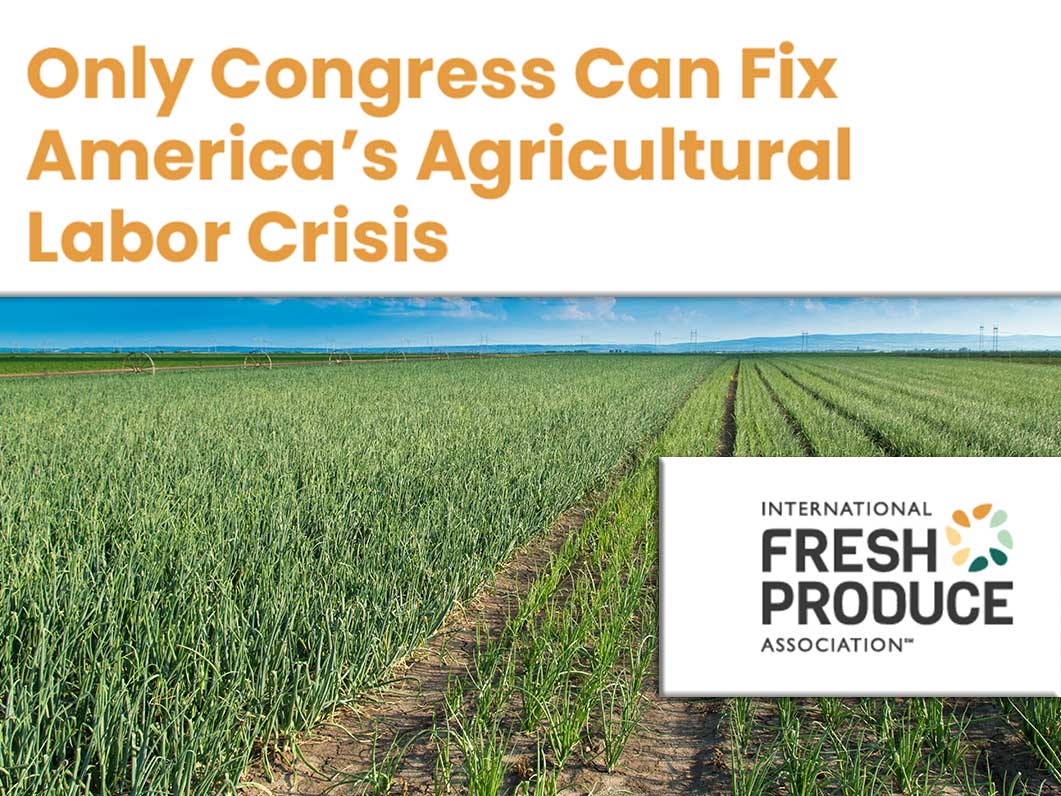On its website at https://www.freshproduce.com/resources/advocacy/americas-agricultural-labor-crisis the International Fresh Produce Association calls on the federal government to resolve the nation’s food security stemming from ongoing labor shortages across the ag spectrum.
Two reports addressing the issue in depth are downloadable in PDF form and linked on the IFPA site, as is an IFPA Infographic on the subject.
The advocacy page notes numerous stats and cites multiple documents. It begins with, “Unless Congress acts quickly, American consumers will rely on other countries to meet our nation’s food needs, jeopardizing food security and national security. Nearly 40 years of inaction by Congress resulted in an overreaching and aggressive regulatory climate leading to a competitive disadvantage for domestic fruit and vegetable growers.”
The page notes, “The H-2A Visa program surged by over 300% from 2012 to 2022. 370,000 jobs were certified, representing between 10%-15% of all agricultural jobs today. “Labor accounts for around 10% of total operating expenses in production agriculture; however, labor expenses for fruits and vegetables are 39% and 29%, respectively.
“In 2024, the National Adverse Effect Wage Rates (AEWR)for H-2A workers was $17.55/hour ($19.75 in California), a 58% increase since 2014.”
It continues, “It is expected that seven major rules will be published over a two-year period with the effect of severely increasing already out-of-control H-2A employer costs. Congress must provide relief for producers, consumers, and the imperiled food supply chain.
“We ask Congress to do the following immediately:
“AEWR Relief: Pass legislation that maintains the current AEWR until further reforms can be made;
“AEWR Reform: Pass legislation that addresses changes in a February 2023 DOL rule that allows workers to earn wages for work they did not do;
“Address Undue Regulatory Burden: Pass legislation that prevents the May 2024 DOL rule that exposes employers to liabilities and potential disbarment from the program for issues outside of their direct control.”
It lists “factors increasing labor cost and impacting labor availability for US growers” as follows: Agricultural job decline isn’t due to low demand but rather a lack of domestic workers. The average farmer today cannot hire 21% of their necessary workforce. “Shrinking Domestic Workforce – US has over one million hired farmworkers, down from 2.33 million 50 years ago, constituting approximately 1% of all US salary and wage workers. “Aging Workforce in US & Mexico – The aging workforce within the H-2A program and shifting economic trends in Mexico represents a future challenge for US growers.”
It also addresses Long-term impacts of increased labor costs and availability, citing: “Financial Strain on Growers: Rising Adverse Effect Wage Rates (AEWRs) under the H-2A program escalate labor expenses and threaten the competitiveness of US growers imperiling the economic sustainability of US agriculture; “Reduced Competitiveness: Escalating labor costs, uncertain availability, and lower wages in competitor countries hinder US growers’ competitiveness, leading to heightened reliance on imports to meet demand; “Impact on Consumers: Higher labor costs raise prices for domestically grown produce. Reduced US production could jeopardize food security and quality.”
There are also “Concerns about Adverse Effect Wage Rates (AEWRs): A Broken Formula Gone Out-of-Control” discussed on the page, with the IFPA looking at: “Flawed Formula: AEWRs should reflect average regional wages. However, data sources and methodologies used for AEWR calculation often do not match local market conditions; “No Predictability: The flawed formula has caused AEWR wages to increase 58% over the last ten years with single year over year increases in some states of 22%;
And “Additional Costs: The AEWR doesn’t account for additional mandated costs associated with the H-2A such as transportation, housing, food, insurance, and visa application fees, all of which have increased due to regulations.”



